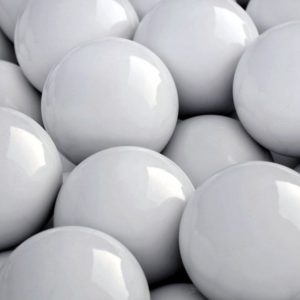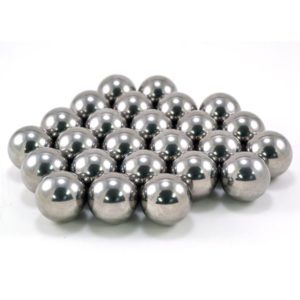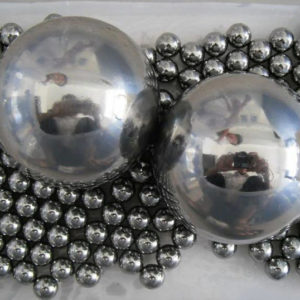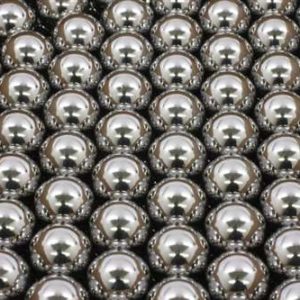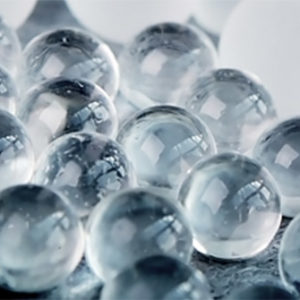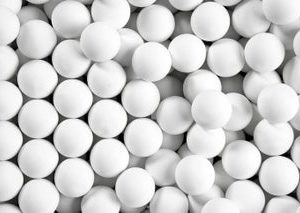Picking the “right” bead – how to select the most appropriate bead for your application.
Chemical compatibility. Is the grinding media going to introduce any chemical contamination issues? All grinding media will contaminate the product being ground to some extent or another even if the contamination is in the ppm or ppb range, so it’s important to consider what’s acceptable and what isn’t. While steel grinding media is attractive because of its relative density and low cost it can produce graying of product especially one that is white or light-colored. Certain products, for electronics and eye-care for example, can have no metallic contamination so the choice is limited.
Physical compatibility. The relative hardness and abrasiveness of grinding media, grinding chamber and product need to be considered. Since the grinding media is inexpensive compared to the equipment it should wear more rapidly.
Grinding media density. The range of specific gravity for commercially available grinding media runs from sp.gr. 1.0 for plastics to sp.gr. 15 for tungsten carbide. It makes sense that you wouldn’t select a very light grinding bead for a highly viscous system or a very dense grinding bead for a low-solids aqueous suspension.
Grinding bead diameter. The same composition of grinding media is often available in different size ranges. Typically the larger the in-feed material, the larger the grinding bead you need to use to do the work. It also follows that the finer the grind you need the smaller the grinding bead. Other size considerations include whether screens or gaps are being used to separate the media from the product – as a rule of thumb the smallest grinding bead diameter should be three times the size of the opening in the screen or gap the progressive jackpot.
Budget considerations. Here there are multiple issues to consider:
- Initial cost. Generally grinding media that exhibit the best wear properties are more expensive than other options. Also the smaller the grinding media the more expensive it can become.
- Grinding bead life. As grinding beads wear they need to be replaced. The longer a grinding bead lasts the cheaper it may be in the long run because of the costs associated with downtime, new beads, disposal and labor.
- Mill wear. Low cost, hard grinding beads may lead to expensive equipment repairs.
- Quality of product. Grinding media with less debris (under-sized or misshapen pieces) will tend to have a longer service life than cheaper material that might contain these artifacts.
Please contact us for up to date pricing.
-
Grinding Media
Ceramics, includes Aluminum Oxide and Zirconium Oxide (sp.gr. 3.5 to 6.1)
Alumina Grinding Media (sp.gr. 2.8 to 3.9)
Available in a range of specific gravities which rises as the alumina (Al2O3) content increases. The grinding media is actually alumina particles held in place by an SiO2 glass phase. Sizes from 400 microns to over 1 inch in beads, balls, satellites (ball with bands) and cylinders. Low to medium cost, small sizes are more costly.
Fused Zirconium oxide Grinding Media (sp.gr. 3.8) Smooth surface leads to low mill wear and longevity. Sizes from 200 microns to 2.5mm. Medium cost.
Sintered Zirconium silicate Grinding Media (sp.gr. 4.0-4.6) ZrO2 + SiO2 + Al2O3, with and without Y2O3 stabilizer. Tight size spreads from 200 microns to 2.6mm. Low to medium cost.
High density Zirconium oxide Grinding Media (sp.gr. 5.5) 95% ZrO2 + MgO stabilizer. Beads from 400 microns to 3.35mm. Cylinders and satellites to 1-1/4″. Medium cost.
Rare Earth stabilized Zirconium oxide Grinding Media (sp.gr. 5.8 to 6.1) ZrO2 + CeO. Yellow or black, very hard. Sizes from 400 microns to 2″. Medium cost.
Yttrium stabilized Zirconium oxide Grinding Media (sp.gr. 6.0) 95% ZrO2 + 5% Y2O3. Best wear properties of all grinding media, very round and very smooth, narrow size spreads. High cost is offset by low wear and minimal contamination.
Please contact us for up to date pricing.
SKU: n/a -
-
Grinding Media
Steel (sp.gr. 7.8)
Various alloys available (low carbon, high carbon, chrome steel, stainless steel, etc.) in a variety of forms:
Ball bearings Good wear, very round but will result in metallic contamination. Cost directly related to material and inversely proportional to size. 1/16″ to 6″.
Shot Irregular shapes with lumps and bumps, but only cost effective alternative for steel in sizes less than 1mm. Inexpensive, sizes from 90 microns to 3mm.
Other forms Steel wire can be cut and formed to produce diagonals, ballcones (looks like a flattened ice cream cone), pins (rods), oval balls and other shapes.
Please contact us for up to date pricing.
SKU: n/a -
Grinding Media
Glass (sp.gr. 2.2 to 3.0)
The first of the “engineered” class of grinding media, glass beads (small balls) and balls were developed specifically for grinding applications where sand wasn’t available. Glass is manufactured in various grades (Lead-free Soda Lime, borosilicate, low alkali, black glass, and others) in sizes from 1 micron to 2 inches.
Good wear properties coupled with reasonable roundness means this is the best material to start with when conducting grinding trials. Low cost.
Glass balls are also available in precision grades and are used in optical resolution systems and as “spacers” for precision electronics. Colored glass balls are used for both engineering and decorative applications.
Please contact us for up to date pricing.
SKU: n/a -

